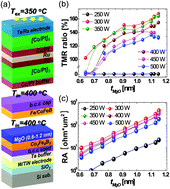Effects of the radio-frequency sputtering power of an MgO tunneling barrier on the tunneling magneto-resistance ratio for Co2Fe6B2/MgO-based perpendicular-magnetic tunnel junctions†
Abstract
For Co2Fe6B2–MgO based p-MTJ spin valves with [Co/Pt]n–SyAF layers ex situ annealed at 350 °C and 30 kOe for 30 min, the tunneling magneto-resistance (TMR) ratio strongly depended on the radio-frequency (RF) sputtering power in a 0.65–1.15 nm thick MgO tunneling barrier, achieving a TMR ratio of 168% at 300 W. The TMR ratio rapidly and linearly increased with a decrease in the RF sputtering power between 300 and 500 W and then abruptly decreased at 250 W since the face-centered-cubic crystallinity of the tunneling barrier improved with a decrease in the RF sputtering power between 300 and 500 W and then abruptly degraded at 250 W. Optical properties measured by spectroscopic ellipsometry, such as the defect state density and energy band gap of a ∼1.0 nm thick tunneling barrier layer, indicate that the RF sputtering power needed to obtain a larger poly grain size for the barrier tends to enhance the barrier's face-centered-cubic crystallinity.


 Please wait while we load your content...
Please wait while we load your content...